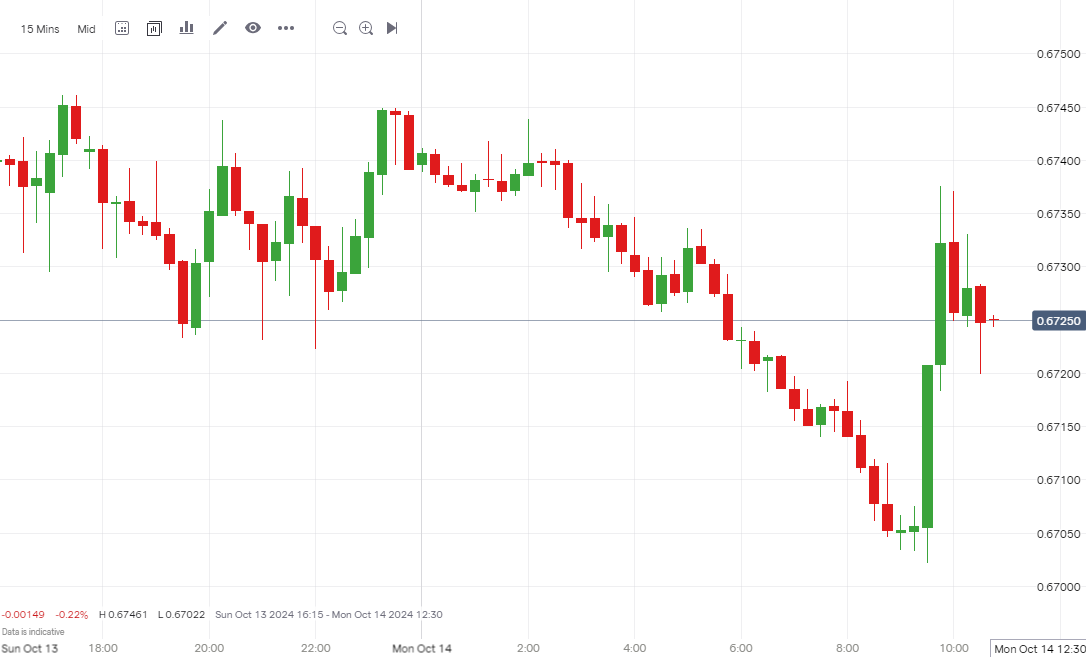Aussie faces downward pressure amid weak economic data from China
Explore AUD/USD's recent drop amid a strong US dollar and weak Chinese economic data—key insights on market dynamics and potential forex strategies for traders navigating these shifts await.

Key Points
- AUD/USD falls to 0.67022 under pressure from strong USD
- China's PPI fell 2.8% YoY in September, inflation at 0.4%
- US dollar index steady near 103.13 due to strong data
- Australia's economy impacted by Chinese economic trends
- Potential support for AUD if China's stimulus gains traction
AUD/USD Falls Below 0.670300
The Australian dollar (AUD) depreciated this morning to 0.67022 under the pressure of a strong US dollar and a lackluster fiscal stimulus plan announcement from China. The AUD/USD pair has experienced volatility in recent weeks, primarily because the Australian dollar serves as a liquid proxy for the Chinese yuan, due to Australia's reliance on exports to China. This relationship makes the Australian currency sensitive to economic developments in China, affecting its value against the US dollar when Chinese economic data disappoints or surprises.
AUD/USD price history

China PPI and Stimulus Measures Fall Short of Expectations
Despite promises of robust economic stimulus, recent data from China indicates underwhelming performance. The producer price index fell 2.8% year-over-year in September, following a 1.8% decline in August. Additionally, the annual inflation rate dropped to 0.4% from 0.6% in August, suggesting subdued consumer demand and potential deflationary pressures. These trends could lead to broader economic challenges, potentially impacting global trade dynamics, given China's central role in manufacturing and exports. For Australia, this poses risks to its economy, closely tied to Chinese demand for its exports.
US Dollar Index Strong on Optimistic Economic Data
The US dollar index remains near a two-month high, trading around 103.13, driven by expectations that the Federal Reserve will not enact significant rate cuts in upcoming meetings. This sentiment is underpinned by positive US economic data, including strong job reports and consumer inflation figures surpassing forecasts. These developments enhance the US dollar's appeal to investors, as stable or higher interest rates attract capital inflows, strengthening the currency.
What’s Next for AUD/USD?
The recent depreciation of the Aussie reflects the dual influence of a strong US dollar and economic challenges in China. The US dollar's robust performance, supported by positive economic data and stable interest rate expectations, attracts investor confidence. Meanwhile, China's weak consumer demand and deflationary risks, despite fiscal stimulus efforts, pose threats to Australia's export-driven economy. The AUD/USD pair's future will likely hinge on developments in China's economic landscape and any changes in Federal Reserve policy. If China's stimulus gains traction or the Fed adjusts its stance, the Aussie could find support.
How to trade AUD/USD
- Open an account to get started, or practice on a demo account
- Choose your forex trading platform
- Open, monitor, and close positions on USD pairs
Trading forex requires an account with a forex provider like tastyfx. Many traders also watch major forex pairs like EUR/USD and USD/JPY for potential opportunities based on economic events such as inflation releases or interest rate decisions. Economic events can produce more volatility for forex pairs, which can mean greater potential profits and losses as risks can increase at these times.
You can help develop your forex trading strategies using resources like tastyfx’s YouTube channel. Our curated playlists can help you stay up to date on current markets and understand key terms. Once your strategy is developed, you can follow the above steps to opening an account and getting started trading forex.
Your profit or loss is calculated according to your full position size. Leverage will magnify both your profits and losses. It’s important to manage your risks carefully as losses can exceed your deposit. Ensure you understand the risks and benefits associated with trading leveraged products before you start trading with them. Trade using money you’re comfortable losing. Past performance is not indicative of future results.
